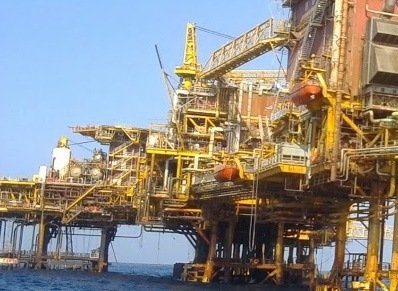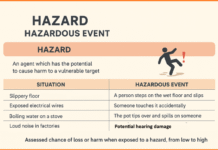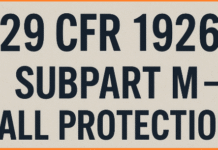Contents
Unit Process
In such processes, by combination (chemical reaction) of two or more chemicals, a new product (compound) is formed. It indicates a chemical change.
Alcoholic caustic fusion: Reaction carried out at lower temperature (105-130°C) using caustic soda or potash and alcohol (like ethanol, methanol, cellosolve, isobutanol).
Animation: Introduction of amino group in the molecule using liquid ammonia or any other animating agent.
Caustic fusion: Reaction carried out in molten caustic potash/caustic soda at temperature above 150°C.
Condensation: Reaction in which two or more molecules combine with the separation of water or simple substance.
CLICK HERE FOR ? Hazardous materials and chemical safety
Halogenations: Introduction of chlorine or bromine in the molecule using calcium hydroxide etc.
Hydroxylation: Introduction of hydroxyl group in the molecule using calcium hydroxide etc.
Nitration: Introduction of nitro group in the molecule using nitric acid or mixed acid.
Oxidation: Introduction of oxygen or removal of hydrogen from the molecule using oxygen liberated by the action of acid and substance rich in oxygen.
Reduction: Introduction of hydrogen or removal of oxygen from the molecule using hydrogen liberated by the action of acid and metal.
Sulphonation: Introduction of sulpha group in the molecule using sulphuric acid or oleum or chlorosulphoric acid.
CLICK HERE FOR ? SAFETY IN CHEMICAL INDUSTRY
Some Hazardous unit processes are given in Table.
| Unit Process | Process Hazard | Application | |
| 1. | Alkylation
Ex-Butylene + isobutene iso-octane | Exothermic, side reaction | Petro and organic chemical |
| 2. | Amination by Aminolysis
Ex – EDC + Ammonia Ethylene diamine. | Gas phase pressure reaction, Exothermic | Dyes, organic chemicals, synthetic fibers |
| 3. | Ammoxidation
Ex – Propylene + ammonia + air acrylonitrile. | Exothermic, toxic effect. | Organic chemical |
| 4. | Carbonisation
Ex – Methanol + CO acetic | Exothermic, toxic effect | Organic chemicals |
| 5. | Condensation
Ex – Phthalic anhydride + benzene anthraquinone | Exothermic | Dye intermediates |
| 6. | Diazotisation & coupling
Ex – Amine + HCL + O2 Diazonium chloride | Exothermic | Dyes |
| 7. | Halogenation
Ex – Ethylene + chlorine Ethylene dichloride | Highly Exothermic | Organic chemicals |
| 8. | Hydrogenation | Exothermic | Fats, waxes, coal processing, pertochemical |
| 9. | Hydrolysis
Ex- Chlorobenzene + water Phenol | Exothermic | Organic chemical |
| 10. | Nitration
Ex-Benzene + Nitric acid Nitrobenzene | Highly exothermic, Explosive | Explosive, dyes, organic chemical |
| 11. | Oxidation
Ex – Alcohol + O2 aldehyde + carboxylic acid | Highly exothermic, Explosive | Organic chemicals |
| 12. | Polymerisation
Ex – Ethylene monomer + dimmer polyethylene | Exothermic | Petrochemicals, estomers, synthetic fibers |
| 13. | Sulphonation
Ex – Benzene + H2SO4 Benzene sulphonic acid | Exothermic, Highly corrosive | Dyes, Surface active agents |
Some other unit processes are Acylation, alcoholysis, aromatisation or cyclization, calcination, carboxylation, causticization, combustion, dehydration, dehydrogenation, double decomposition, electrolysis, esterification, fermentation, Fischer-Tropsch reaction, Friedel-Crafts reaction, hydroformylation (oxo), hydration, ion-exchange, isomerisation, neutralisation, pyrolysis or cracking, reduction, saponification etc.
CLICK HERE FOR ? Manufacture, Storage and Import of Hazardous Chemicals Rules 1989
Hazards associated with unit processes/Operations are
- Mechanical hazards e.g. pressure release, leaks, burns, noise, equipment or utility failure.
- Reaction hazards due to failure to control exotherms, incompatible materials, side reactions, feed ratio or rate variation etc.
- Environmental hazards such as air pollution, odour problems, spills etc.
- Toxicity and health effects.
- Flammability hazards due to explosive mixture.
Unit Operatios
In such operations, there is no chemical reaction to form a new product. It indicates no chemical change but mechanical or physical change like distillation, cutting, heating, cooling, drying, mixing grinding, washing, packing, transferring, filtering, handling, radiation etc.

Some general Operations in a sequence are as follows –
Steam distillation: Live steam is passed in the still to recover the solvent. Vapours of solvent and water are passed in a shell-tube type condenser and cooler. Then the cooled distillates are taken in separator where solvent and water separate out and are diverted to respective storage.
CLICK HERE FOR ? MAJOR ACCIDENT HAZARDS (MAH) CONTROL SYSTEM
Heating: Heating operation can be done either directly or indirectly. In direct heating, steam. is passed in the material directly to heat the material. In indirect heating, heating media (eg. steam, hot oil, hot flue gases etc.) are passed in jacket / coil of the vessel.
Cooling: It can be done directly or indirectly. In direct cooling, ice or cooled water is added to the material directly. In indirect cooling, cooling media (raw water, chilled brine, cold oil etc.) are passed in jacket / coil of the vessel.
Drowning means transferring reaction mass from his reaction vessel to a tank which is containing water r other medium (e.g. dilute acid, dilute alkali etc.)
Filtration: This operation is for separating solids and liquids. The conventional items used for this peratlon are press nutch, centrifuge. The filtraticns can be done either under vacuum or pressure or atmospheric pressure.
Pulverization: This operation is done to reduce size of the material. Usually crushers, pulverizes, ST mill are used.
CLICK HERE FOR ? LINE OF FIRE
Blending: This operation is done in a blender to mix thoroughly two or more dried products.
Washing: This operation is done in presses, nutches or centrifuge to remove soluble impurities and acid/alkali from the product.
Packing: is filling up of finished product in the containers.
Storing of liquid raw materials: Bulk liquid raw materials which are received in tanker loads are emptied out in storage provided for this purpose.
Unit Operations are classified as under
- Mechanical unit operations – (1) Size reduction (2) Size enlargement, mixing, agitation, blending and kneading and (3) Separations e.g. gravity settling, filtration, centrifugal, impingement, screening jigging, magnetic, electrostatic, hydro and flotation.
- Mass transfer Operations – evaporation, distillation, absorption, humidification, extractio leaching, crystallization, ion exchange, adsorption, drying.
- Heat transfer operations – conduction, convection, radiation.
- Material handling, transportation & conveyance
Pumping, compression, fluidization and containerization (solid filling).
CLICK HERE FOR ? SAFE OPERATING PROCEDURES (SOP)
Controls: Distillation operation needs trip and alarm device to stop heating as soon as cooling stop In addition, the Vessel hould have a safety valve to discharge any accidental pressure.
In centrifuging blending, grinding, crushing, pulverizing or sieving of any flammable o explosive substance, inert blanketing. earthling and avoidance of sources of ignition are essential.
Where stirring and heating both are going on, stirrer failure alarm and a device to cut heat source, are necessary.
Other Process and Operations
it is utmost important to understand chemical process before understanding their safety aspects. Therefore some such processes are explained below in brief.
Absorption of gases: The solution of gases in liquids or absorption of gases by solids through the whole body. It is penetration or consumption of one substance by another eg. Scrubbing.
Adsorption: The adherence of a substance on a surface, the substance that adsorbs is adsorbent and that is adsorbed is adsorbate.
It is relatively a slow penetration or consumption of gas or liquid particles through the surface of another substance mostly solid or liquid, It is used to remove colours, odours and water vapours through activated carbon, activated alumina, silica gel etc.
CLICK HERE FOR ? HIRA
Broinination : A reaction in which one or more bromine atoms are substituted for hydrogen atoms in an organic molecule.
Calcinations : Strong heating, conversion of metals into their oxides by heating in air.
Carbonation: Treatment With carbon dioxide usually for formation of carbonates.
Catalysis and Catalyst: The alteration of the rate of chemical reaction by the introduction of a substance (catalyst) that remains unchanged at the end of the reaction small quantities of the catalyst are usually sufficient to bring the action about or to increase its date substantially.
Chain reaction : Any self-sustaining molecular or nuclear reaction, the products of which contribute to the propagation of the reaction, viz. nuclear fission.
Decomposition : The breaking up of chemical compounds under various influences e.g. by chemical action, by heat (pyrolysis), by an electric current (electrolysis), by biological agents (biodegradation) etc.
CLICK HERE FOR ? ELECTRICAL SAFETY
Distillation: The process of converting liquid into vapour, condensing the vapour and collecting liquid or distillate. Used for separating mixtures of liquids of different boiling points or for separating a pure liquid from a non-volatile constituent.
Electrostatic precipitation: A widely used method of controlling the pollution of air (or other gases). The gas, containing solid or liquid particles suspended in it, so that the particles are attracted to and deposited upon, the positive electrode.
Endothermic process: A process accompanied by the absorption of heat.
Evaporation: The conversion of a liquid into vapour, without necessarily reaching the boiling point. used in concentrating solutions by evaporating off the solvent.
Exothermic process: A process in which energy in the form of heat is released.
Extraction: The process of separating a desired constituent from a mixture by means of selective solubility in an appropriate solvent. Also used to describe any process by which a pure metal is obtained from ore.
Fermentation: A chemical change, brought about in organic substances by living organism (yeast, bacteria, etc.) as a result of their enzyme action.
Fractionating column: A long vertical column, containing rings, plates or bubble caps that is attached g to a still. As a result of internal reflux a gradual separation takes place between high and low boiling ’fractions’ of a liquid mixture.
Freezing: Change of state from liquid to solid it takes place at a constant temperature (freezing point) for any given substance under a given pressure (normally standard atmospheric pressure).
CLICK HERE FOR ? UN CLASSIFICATION OF CHEMICAL
Fumigation: The destruction of bacteria, insects and other pests by exposure to poisonous gas or smoke.
Hydrogenation: Subjecting to the chemical action of or causing to combine with hydrogen.
Leaching: Washing out a soluble constituent.
Neutralisation: The addition of acid to alkali, or vice versa, till neither is in excess and the solution is neutral.
Photochemical reactions: Chemical reactions initiated, assisted or accelerated by exposure to light.
Pyrolysis : Chemical decomposition by the action f of heat.
Radiation hazard: The potential danger to health resulting from exposure to ionising radiation or the consumption of radioactive substance.
Stabilisation: The prevention of chemical decomposition of a substance by the addition of a stabiliser or negative catalyst stable means which cannot readily decompose.
Sublimation: the conversion of a solid direct into vapour and subsequent condensation without melting.
Tanning: The conversion of raw animal hide into leather by the action of substances containing tannin, tannic acid, or other agents.
Vacuum distillation: The process of distillation carried out at reduced pressure and boiling point Vacuum lowers boiling point. It is useful for distilling high boiling and heat sensitive materials such as heavy distillates in petroleum, fatty acids, vitamins etc.
CLICK HERE FOR ? SAFETY EDUCATION AND TRAINING
Exothermic Reactions
In exothermic reactions, heat is given out as reaction proceeds. This release of heat raises the temperature of reaction mass.
Approximately for every 10 degree C rise in temperature, reaction rate doubles. Thus with increase in temperature, reaction proceeds faster and still more heat given out.






Usefull knowledge
Thanks sir